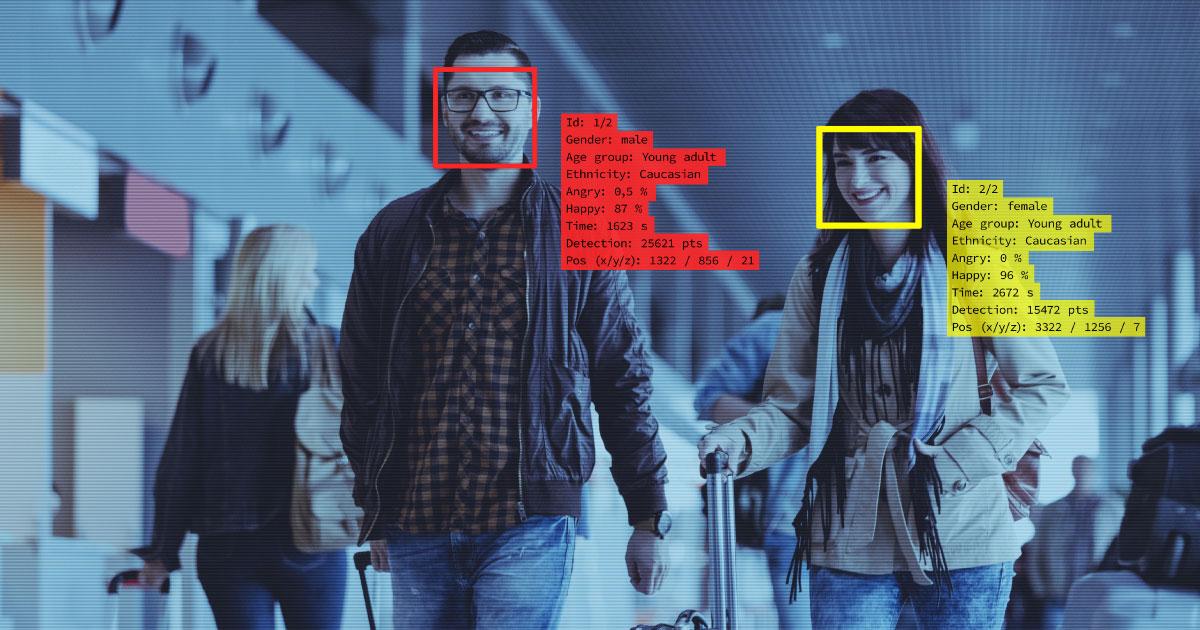
This article was originally published by THINK MICE.
The meetings industry brings to mind advanced technological solutions. Today their application in the production of all types of events seems to be essential. Interactive, engaging and unforgettable experiences are intended to generate not only a “wow effect” for the spectators, but also create the so-called fear of missing out (FOMO). Increasingly advanced and original technologies, making it possible to stand up to this task, are springing up in the market. Facial recognition systems are unquestionably among the most prominent options.

Popular Tools
Although it has not been applied on a wider scale until recently, the facial recognition technology itself should not come as a surprise to anyone. After all, owners of the latest iPhones are using it every day to unlock their smartphones with the Face ID feature and authorise their purchases from the iTunes Store and App Store.Airlines are also investing in systems of this kind, perceiving them as a faster and safer method of verifying the identity of travellers. DeepFace and FaceNet algorithms introduced by Facebook and Google enable automatic facial recognition that achieves nearly 100% accuracy rate. The increasingly popular tool is now also entering the MICE realm, winning acclaim of jury members of industry’s most important competitions as the best way of speeding up the process of event check-ins.
Market Leaders
The largest progress in the implementation of facial recognition in the meetings sector was made by two start-ups – Belgian Field drive and the US Zenus Biometrics. In last year’s edition of IBTM World Tech Watch Award and Event Technology Award competitions the two companies were recognised as top partners specialising in providing the discussed technology.The product they developed together combines the high functionality of self-service checkin kiosks (part of the Field drive portfolio) with a facial recognition application created by Zenus Biometrics. It has already been successfully applied in more than 30 events in Europe and United States, including Mega Camp held at Austin Convention Centerin Texasin last August.
This was the second event staged by Keller Williams Realty to deploy the technology in question. According to data compiled by Field drive, 69% of Mega Camp’s 8,000 participants decided to register via a facial recognition system, an increase of 17% in comparison with Spring Masterminds, a previous event held only several months earlier in May 2018. “The gathered results only confirmed our expectations. The ratio of people interested in the product is considerably higher in the case of recurring events, as their participants had enough time to become accustomed to the registration process”, explains Zuzanna Rachowska, Marketing Manager & Event Project Manager atFielddrive.
This February the innovative registration method will soon be put to its most demanding test during a New Orleans conference, which will be attended by approx. 17,000 delegates. NeoFace is another noteworthy company offering similar technological solutions, whose NeoFace® Watch and NeoFace® Reveal software is put to use mostly in the field of security. The US company Expo Logic is a trusted supplier ofregistration services, including mobile applications.
Quickly and Effectively
Fielddrive features API (application programme interface)integration with mostregistration platforms, such as i. a. Eventbrite, Aventri and EventMobi. Data needed to print ID badges are downloaded from a given platform. In addition to basic information, they might include a personalised event agenda or the individual dietary preferences of participants. The ID badges are then printed in self-service check-in kiosks and the whole procedure does not take more than six seconds.Even though we are dealing with a high-tech product, it is actually highly intuitive and user-friendly. At the stage of online registration, a participant is asked to agree to a check-in using the face recognition technology and to send a portrait photo ortake a selfie with the help of an in-built camera. Next, the photos are converted into anonymised biometric data that are stored in the cloud until an event begins and then automatically deleted after its wrap-up.
On the day of an event, a participant is asked to “smile” to a camera set in a kiosk and thus enable error-free facial recognition. Five second slater an ID badge is printed and information about successful registration of a given participant is sent to the system.
Before a facial recognition application was introduced, the registration consisted of scanning a barcode included in an e-ticket or entering a name into a search engine in the software installed in a kiosk. “Despite numerous advantages resulting from the applied technology, which i. a. eliminates the need to print individual ID badges in advance, organisers – particularly of major meetings – opt for the so-called soft check-in on the day before the event. Their decision is influenced by long lines of people waiting to kiosks and a concern that several thousand participants will not be able to check in simultaneously on the day of the event”, explains Zuzanna Rachowska.
Broader Application
In addition to the function of on-site event registration, facial recognition systems boast several other applications in the meetings industry, which were discussed by Julius Solaris, editor of Event Manager Blog, in hisreport “Facial Recognition and Events: A Comprehensive Guide (2018)”. The list includes: Watch lists – when an organiser anticipates the arrival of people not welcome at a given event, he can add them to the so-called watch list. This innovative method makes it possible to immediately identify them with the help of a video camera at the registration phase or even during the event.An additional advantage involves the option of programming the system so that it informs security staff and police about the presence of a person that should be kept out of the venue. “Our customers, especially the ones specialising in supplying accurate technological solutions (such as Synopsys) are concerned with preventing ‘data leakage” and making sure that the corporate know-how remains safe.
A face recognition tool makes it much easier to guarantee that unwelcome attendants will not become involved”, explains Zuzanna Rachowska. Moreover, the technology makes it possible to compile so-called white lists for very important persons, whose satisfaction with the meeting is a priority for the organiser.
Session tracking – face recognition systems also supply information about attendance figures and participants’ interest in a given educational session. Such feedback can be exceptionally helpful when booking conference rooms or selecting speakers for an event’s successive edition. “Session tracking with face recognition can be as simple as putting a tablet or cell phone on a stand near the entrance of each room. (…) There is no need for special hardware and expensive installation costs”, Julius Solaris emphasises in his report.
Heat maps – data concerning the number and profile of people visiting an exhibitor’s booth at an industry trade fair will help him prepare much better for the next edition and thus impact his financial results. The same information can be applied by an organiser when working on a price list of exhibition space hire. Managers of event venues also recognised the potential of innovative facial recognition technology. A great example is provided by RAI Amsterdam Exhibition and Convention Centre, the first venue planning to add a face recognition tool to its offer.
Is There Anything to Be Afraid Of?
Despite numerous advantages of facial recognition systems, only 20% to 70% of participants (depending on event type) decide to register using the discussed method. The protection of personal data is among the most troubling issues. Panos Moutafis, co-founder and President of ZenusInc., argues that the procedure is in full compliance with GDPR regulations. “The photos sent by users are then converted into biometric data applied in check-in kiosks. They are deleted immediately upon reception, while the database is removed from Field drive and Zenus servers within seven days from an event’s completion.What is more, neither photographs nor biometric data are linked with the personal data of participants, but rather with identification numbers that simply cannot be linked with the concrete profile of a given person”, explains Panos Moutafis. On the other hand, distributors of the technology in question unanimously emphasise that it is the duty of an organiser to inform guests about the course and advantages of registration using facial recognition, placing distinct emphasis on the optional character of the service.
Within Arm's Reach
The future of facial recognition looks promising. “Brand-new technological solutions will make it possible to recognise the emotions and mood of event guests. Soon facial features of participants of an educational session will tell usif they are bored or excited”, explains James Morgan, owner of Event Tech Lab. This knowledge not only constitutes direct feedback about an event’s success, but also makes response to the needs of participants much faster.The Emogram application, currently available only as a beta release, measures 11 basic human emotions in about five minutes. Field drive is working on introducing facial recognition technology into HoloLens, Microsoft’s mixed-reality device. Finally, in addition to improving security, the innovative tool can also perform other, more advanced roles.
Based on information made available during the registration process, a hostess will be able to welcome participants with their favourite cocktail and show them to the place of their first meeting. Another high-tech product,the Zenus smart camera allows to measure the level of participant satisfaction and the popularity of exhibition booths at trade fairs. The latest Zenus devices will be launched to a wider audience by the end of the first quarter of 2019.

